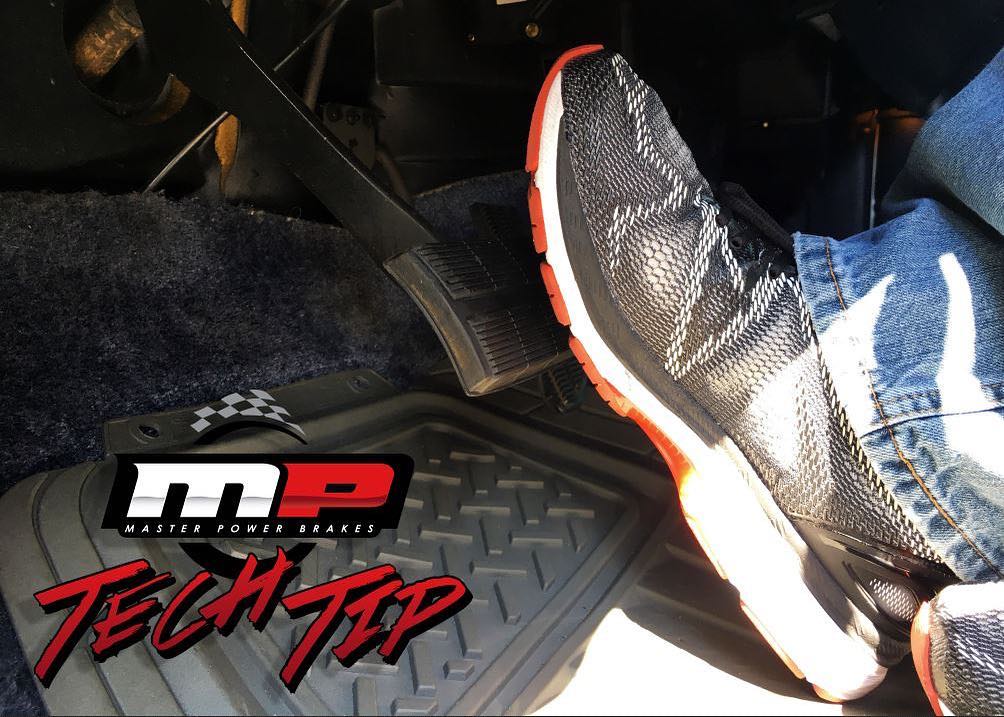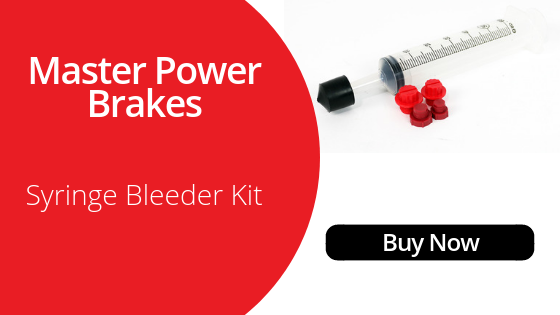Our tech experts get asked time and again:
Why is my brake pedal soft?
And…
What causes a soft brake pedal?

We’ve outlined the top 8 causes of a soft brake pedal based on conversations with our customers, as well as how to troubleshoot and fix it if you have this problem.
1. Air in the System
The most common reason for a soft brake pedal is simply air still in the system. The easiest way to diagnose this problem is to pump the brake pedal gently a few times. In doing so, the pedal should become firmer with each gentle press of the pedal.
If it does, then the necessary answer is bleeding the brakes. The hardest part about getting air out of the system is that we can’t see air and we are forced to think about air and what it does.
Air will generally always find its way to the top.
This could be simply in a brake line that has a funny bend in it that goes in an odd upward location, or it could be trapped within a high point in a caliper above the brake bleeder. To remove the air in a caliper, it may be necessary to remove the caliper and move it around to try and get the air pocket to get into a place where bleeding the brakes will move it through and out of the line.
Read: How to Bleed Your Brakes by the Numbers
If it is felt that air is in the system and you are having difficulty in finding it, we use a simple trick of blocking off portions of the brake system. To do this, block off the front calipers and apply the brakes and then block of the rear part of the system and apply the brakes. If the pedal improves and loses that soft feeling, you can just about guarantee the whereabouts of the air and from there can at least start to narrow down your search to the front or rear of the vehicle.
Just remember one thing, it doesn’t matter how much brake fluid you bleed through the brake system. We constantly hear people say, “We’ve bled over a gallon of brake fluid through the system”. The air pocket can still be there no matter how much fluid gets pushed through the system.
Tech Tip: If the air pocket is in a caliper or line that has an odd setup, the line must be repositioned to allow for the air pocket to clear.
2. Fluid Leaks
This kind of seems obvious, but definitely worth mentioning, as there are some tricky situations. Visible brake fluid leaking from a port or fitting is an obvious sign of a brake fluid leak. Because the fluid is pushing out of the system, the system never reaches a point where it can start to move the pistons within the calipers or wheel cylinders and therefore, causes a soft pedal.
The fix here is quite obvious:
- Repair the leak
- Do a complete bleeding of the brake system
This two-step fix ensures removal of any and all leaks from the system.
You might find your situation is not quite so obvious. This can happen when there is a leak at a fitting but no fluid coming from the port of fitting. It is possible for a fitting to actually pull air when the pedal is returning back to its resting position. This air entering the system is going to obviously create a situation where the brakes will need to be bled again.
The fix?
- Find and correct the faulty fitting
- Do a complete bleeding of the brake system
3. Contaminated Brake Fluid
Fluid has gone too long without being changed
Brake fluid is just like the oil in your engine and other mechanical systems in your vehicle.
It is recommended to change your brake fluid at minimum, every two years.
If the fluid goes too long without being changed, the fluid can actually absorb moisture into the system and therefore then change the compression characteristics of the fluid.
Vehicle contains a mixture of fluid types
One other scenario within contaminated brake fluid is if a Dot 5 Silicone Fluid was used in a brake system that had a Dot 3 or Dot 4 fluid originally. The Dot 5 fluid will not mix with any other type of brake fluid and can cause the system to gum or gel up. Also, if the components within the system were not manufactured using the proper type of rubber, the seals can actually swell up, change shape or start leaking. This too will cause a soft pedal.
Should this be the case for your application, a complete clean out of the brake system will be required.
4. Booster Pin Gap
In this scenario, the booster pin gap between the brake booster that goes into the back of the master cylinder may be too large.
What’s it feel like?
“I push the pedal down and nothing is happening, then all of a sudden, there seems to be a pedal.”
The fix?
- Pull the master cylinder forward and measure the gap.
- If the gap is over the recommended .020”, the pushrod will require adjusting to bring that gap into a proper depth.
5. Incorrect Master Cylinder Bore Size
This gets a little more difficult to explain but can be a major contributor to a soft brake pedal. Obviously, the master cylinder bore size is dependent on what the entire system consists of. Calipers with multiple small pistons will typically use a smaller bore size master cylinder than a caliper with a single, large piston.
The problem:
If too small a bore is used in the master cylinder, it will take much more travel distance to generate the proper amount of volume and line pressure to obtain proper piston travel in the caliper to then obtain proper clamping force.
Getting this right is important since too large a bore size will cause the direct opposite effect: a pedal that takes tremendous effort to get the needed volume and line pressure.
6. Component Failure
This is usually centered around the master cylinder but can also be contributed to other components in the brake system like wheel cylinders or calipers.
Master Cylinder Internal Seals Fail
The master cylinder is the usual suspect due to the internal seals having failed. This can usually be diagnosed when a somewhat soft pedal gets worse. Pump the pedal gently and then hold the brake pedal. If while holding the pedal it starts to creep downward, you more than likely have a master cylinder that is leaking internally and not able to keep pressure at the necessary amount.
The fix?
- Replace the master cylinder
- Do a complete bleeding of the brakes.
7. Brake Hose Leak
This goes a little past the as mentioned above fluid leaks. If the brake hoses are old, they can actually be leaking air through the outside of the hose but not leaking fluid. Remember, air will go places that fluid will not. If the inside of the hose has broken down, air will enter and exit the hose and almost be the same scenario as a fluid leak. Unfortunately, there really isn’t a way of diagnosing this problem and will simply require changing the hoses. The good thing is that if you look at the hoses and feel there may be a chance of this, they probably are old enough that they need to be changed anyways.
8. Mechanical Interference
This is a lot more uncommon but worth mentioning. There are instances where everything works fine. The pedal feels good and there aren’t any known issues. Then all of a sudden, usually after something specific, the pedal will suddenly become soft to the point of almost feeling like nothing is there but can usually be pumped back up to solid within a couple of presses on the brake pedal. In this situation, we have seen where at full turn of the wheel, the caliper might come in contact with some portion of the frame or suspension. When this happens, it will push against the caliper and either flex it significantly or if the caliper is of a floating kind, cause it to slide on the pins. If this happens, fluid is pushed out of the caliper and pressing the brake pedal the first couple of times literally is filling the caliper up with fluid just like when new components are installed. To correct this can be challenging at times depending on the scenario and every situation is probably a little different.
We hope these scenarios have helped point you in a direction that eventually allows you to figure out where and why you have a soft brake pedal.
If you still need help, we are always here to talk you through a problem and keep you off the ledge.
Our phone number here is 888-249-9425 or drop us an email at info@mpbrakes.com.

